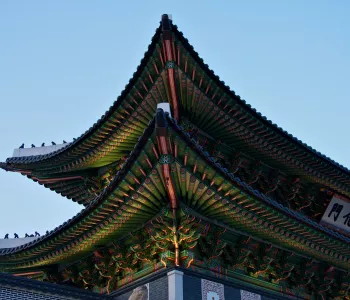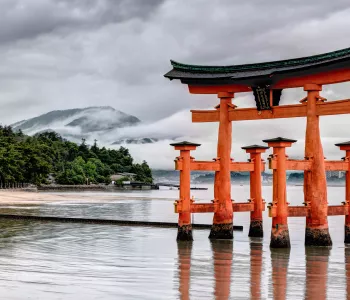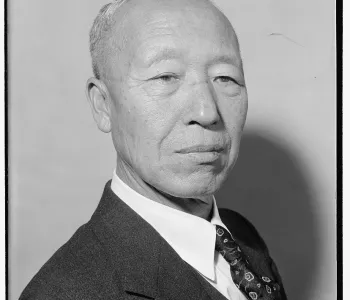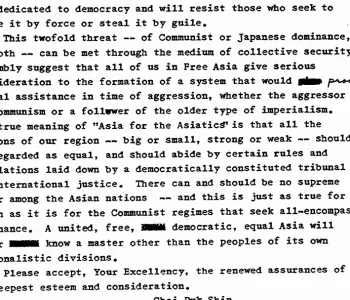d'Vinci

Rhee, Francesca Donner 1900- 1992
Francesca Rhee was the Austrian-born wife of Syngman Rhee and served as the First Lady of the Republic of Korea from 1948 until 1960.

Francesca Rhee (1900-1992), née Franziska Donner, was the Austrian-born wife of Syngman Rhee (1875-1965); she served as First Lady of the Republic of Korea from 1948 until 1960, when Rhee was forced to resign the presidency in the aftermath of the student-led April 19 Revolution.
Born and raised in a Viennese suburb in a solidly middle class family, “Fanny,” as she was known, was professionally trained as an interpreter in English and French. She met Rhee in 1933, when Rhee was attending the Geneva Disarmament Conference. Despite a significant gap in age (Rhee was 25 years her senior) and backgrounds, as well as familial opposition on her part, they were married the following year in New York. It was a second marriage for both that resulted in no natural issue, although the couple later adopted two sons: Yi In-su (1931- ) and Yi Kang-seok (1937-1960).
Donner was a dutiful supporter of her husband’s career, assisting his efforts to promote Korean independence to the end of World War II and, after 1945, his political career. According to Rhee’s biographer Lew Young-Ick, during the early years of their marriage she managed his daily affairs throughout his peripatetic years in exile in New York, Washington, and Honolulu; she also aided in the preparation of Rhee’s book, Japan Inside Out (1940), a critique of Japan’s expansionist policies. Following Japan’s surrender, Donner traveled to Korea for the first time in October 1945. She assumed the office of First Lady in August 1948 upon Rhee’s inauguration as President of the Republic of Korea.
Donner’s significance as First Lady is somewhat mixed. By virtue of her office she was an unprecedented female public figure, and she sought to ingratiate herself to Korean society by accompanying Rhee at public functions in Korean national dress. Despite such efforts she failed to enjoy much popularity, which may have been due to her ethnicity, cultural differences, or reportedly cold personality (her chief virtue was said to be her frugality). Donner’s limited comprehension of the Korean language motivated her to seek English-speaking confidantes—a propensity that some historians suggest amounted to meddling in personnel decisions of the presidency.
Following Rhee’s ouster in 1960, the couple settled in Hawai’i, where Rhee had been an independence activist before Japan’s surrender. Following Rhee’s death in 1965, Donner initially returned to Vienna, but at the invitation of the South Korean government resettled in Seoul in 1970; her return was arranged to coincide to the very day with the anniversary of President Park Chung Hee’s May 16 Revolution. She resided at Ihwajang, Rhee’s former residence, with her adopted son Yi In-su’s family until her death in 1992.
More information about Francesca Rhee's life can be found in:
Lew, Young Ick, The Making of the First Korean President: Syngman Rhee’s Quest for Independence, 1875-1948 (Honolulu: University of Hawaii Press, 2013).
Yu Yang-su, “Han’guk ch’odae p’ŏsŭt’ŭ reidi ŭi ch’osang—Osŭtŭria Pin esŏ mannan P’uranch’esŭk’a Ri yŏsa,” Wŏlgan Chosŏn xx (December 1995), pp. 518–32.
Born and raised in a Viennese suburb in a solidly middle class family, “Fanny,” as she was known, was professionally trained as an interpreter in English and French. She met Rhee in 1933, when Rhee was attending the Geneva Disarmament Conference. Despite a significant gap in age (Rhee was 25 years her senior) and backgrounds, as well as familial opposition on her part, they were married the following year in New York. It was a second marriage for both that resulted in no natural issue, although the couple later adopted two sons: Yi In-su (1931- ) and Yi Kang-seok (1937-1960).
Donner was a dutiful supporter of her husband’s career, assisting his efforts to promote Korean independence to the end of World War II and, after 1945, his political career. According to Rhee’s biographer Lew Young-Ick, during the early years of their marriage she managed his daily affairs throughout his peripatetic years in exile in New York, Washington, and Honolulu; she also aided in the preparation of Rhee’s book, Japan Inside Out (1940), a critique of Japan’s expansionist policies. Following Japan’s surrender, Donner traveled to Korea for the first time in October 1945. She assumed the office of First Lady in August 1948 upon Rhee’s inauguration as President of the Republic of Korea.
Donner’s significance as First Lady is somewhat mixed. By virtue of her office she was an unprecedented female public figure, and she sought to ingratiate herself to Korean society by accompanying Rhee at public functions in Korean national dress. Despite such efforts she failed to enjoy much popularity, which may have been due to her ethnicity, cultural differences, or reportedly cold personality (her chief virtue was said to be her frugality). Donner’s limited comprehension of the Korean language motivated her to seek English-speaking confidantes—a propensity that some historians suggest amounted to meddling in personnel decisions of the presidency.
Following Rhee’s ouster in 1960, the couple settled in Hawai’i, where Rhee had been an independence activist before Japan’s surrender. Following Rhee’s death in 1965, Donner initially returned to Vienna, but at the invitation of the South Korean government resettled in Seoul in 1970; her return was arranged to coincide to the very day with the anniversary of President Park Chung Hee’s May 16 Revolution. She resided at Ihwajang, Rhee’s former residence, with her adopted son Yi In-su’s family until her death in 1992.
More information about Francesca Rhee's life can be found in:
Lew, Young Ick, The Making of the First Korean President: Syngman Rhee’s Quest for Independence, 1875-1948 (Honolulu: University of Hawaii Press, 2013).
Yu Yang-su, “Han’guk ch’odae p’ŏsŭt’ŭ reidi ŭi ch’osang—Osŭtŭria Pin esŏ mannan P’uranch’esŭk’a Ri yŏsa,” Wŏlgan Chosŏn xx (December 1995), pp. 518–32.






